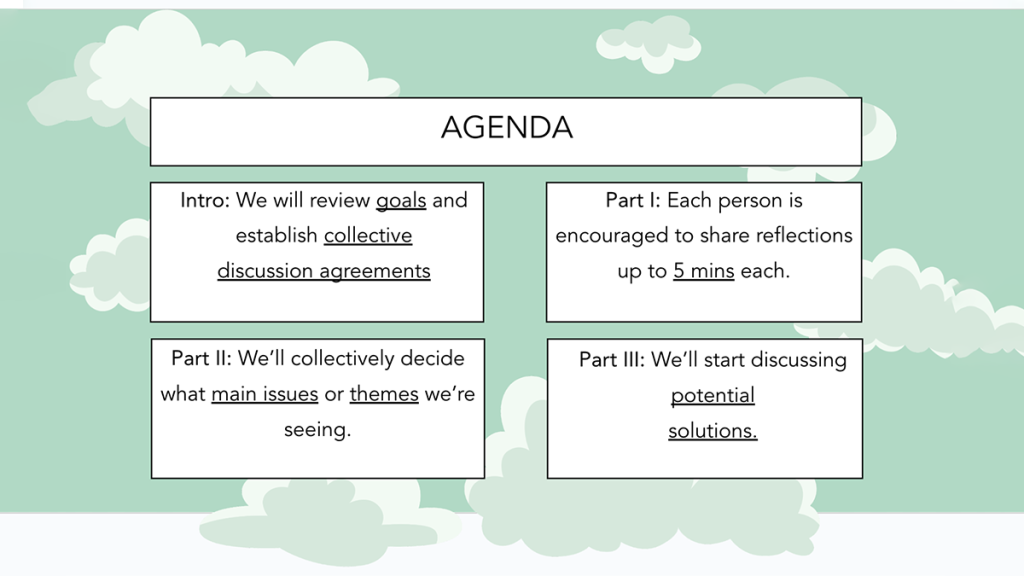
How to host reflection sessions in your newsroom
At times of high stress, create space for listening and problem-solving
We are very proud of The Appeal and all the ways we have built a very different kind of organization — including the ways in which we’ve enshrined team-based decision-making in our bylaws. We also take our values of self- and community care seriously and have implemented practices and policies designed to support our team.
But even with all the measures we take to center care, burnout still gets the better of us—just like staffers in every other newsroom. Fortunately, we’re pretty good at learning from the experiences we’ve had in other workplaces.
We identify when we need to pause what we’re doing and prioritize taking care of our team. We can tell when frustration is starting to inform the way our team communicates on Slack and in meetings. Through one-on-one check-ins with our staff, we know when people are struggling with our workflow or how we’re working with each other. Almost always, those frustrations and conflicts are a direct result of stress and burnout. So, we stop, reset, and hold reflection sessions to collectively address the biggest challenges of the moment.
We hope that demystifying how we handle stress and burnout at The Appeal will help you recognize and address tensions on your team before they boil over.
What is a reflection session?
We created reflection sessions to make a safe place for people to talk out their frustrations during challenging times. But we didn’t want to leave our team feeling directionless afterward, so we designed these sessions with three goals in mind:
- Create space for people to share how they’re feeling.
- Walk away with a sense of possibility and positivity about changes we can make.
- Begin to identify what we can change that will benefit the most people.
We then came up with a plan to achieve these goals by breaking our sessions up into three sections:
- Open sharing
- Identifying common issues/themes
- Brainstorming solutions
So far, our staff say reflection sessions have left them feeling heard and supported, and have eased tensions in our newsroom. And we walk away with actionable steps to improve how we work together.
Here’s a template of The Appeal’s Listening Session slides and some guidance on how we lead our team through these conversations.
Step One: Prepare
A reflection session may sound like it involves no work. But, as a leader, you need to set your team up for success. Good communication is nobody’s default, so establishing a safe space for empathetic and productive conversations requires preparation.
Here’s what you can do to get yourself and your team ready:
- Decide what you want people’s thoughts on. Perhaps you just finished a complicated project and want team members to share their experiences. Or journalists just finished covering a very stressful or difficult story and you want to create a safe space for people to share how they’re doing. Or maybe everyone is overworked, burnt out, and not their best selves.
At The Appeal, we then ask this prompt: What’s not working for you?- What repeatedly makes you frustrated, upset, or annoyed at work?
- What overburdens or overwhelms you at work?
- What do you need to feel seen and heard in this moment?
- Write down — and share ahead of time — the speaking order. This helps people who get very stressed about being called on to speak at a random time and helps ensure everyone truly listens to one another.
- Document the ground rules you want your team to agree on. Ground rules are collective agreements for everyone at the session and often define the way you want team members to share, listen, and respond. At The Appeal, our ground rules are as follows:
At The Appeal, our ground rules are as follows:- Sharing is voluntary
- Be considerate: Give each other the full time to speak and try to talk about roles, not individuals.
- We won’t respond: To ensure we hear and value each other’s experience, we can ask to clarify what a speaker said; otherwise, we won’t respond.
- Center yourself: Share how situations affect you personally.
- Say it messy: You may not be able to say what you want to perfectly. Say it anyway.
- Assume best intentions: We may mess up from time to time but we’re all working toward a common goal and in this together.
- Prepare what you, as a leader, would like to share. Workplace power dynamics can make it hard to remember that leaders are also humans who have their own challenges and who also get overworked and stressed out. Taking part in your reflection session helps your team know where you are at and allows you to also feel heard and cared for. We do suggest sharing last so you don’t sway other team members. But share!
- Find a timekeeper tool. If you’re holding the session in person, you could use an egg timer or stopwatch app. Remote workplaces can use one of the clock apps on Zoom that puts a timer on everyone’s screen.
- Think about the common themes you might hear from staff and any potential solutions you would have for those. This can help kickstart the second section of the session. It can also help you, as a leader, not feel caught off guard by the feedback you get from your team.
- Think about some of the action steps your team can take to address the common issues you think will come up. As a leader, you likely inform your team’s priorities, so coming to the table with your own solutions will send the message that you are serious about making things better.
- Give your team a heads-up that this session is happening. Lock it in on the calendar. Provide the prompt and the sharing order so folks can also begin preparing what they may like to share. For our seven-person team, we set aside two hours — and, if we don’t get through everything, we set up follow-up sessions. But we find that after two hours of vulnerable conversations, our team’s (and our own!) eyes start to glaze over.
Hold your reflection session
Now that you’ve put time and effort into preparing to reflect with your team, you can go into your session with calmness. Or not. If you’re anything like us, you’ll be nervous until the session begins, or until you share, or until the session is over. But trust us: the calmness will come. And even as a bundle of nerves, you can feel confident that you’ve done everything you can to set your team up for a safe and empathetic conversation.
As you get ready to lead your reflection session, here are some tips for making the most out of each section.
1. Sharing
When the meeting begins, you can help set the tone for the day by asking each person to share in one word how they’re feeling. This check-in question helps gauge everyone’s starting point without eating up too much time.
Then, take people through the agenda, collective agreements, and order of speakers. Remind everyone that sharing isn’t necessary but is very much welcomed. Then, set the timer to five minutes and invite the first person to begin sharing.
It may seem counterintuitive, but the most powerful part of this process is not responding — whether it’s you or your team members. That means not saying “Yes,” “Totally agree,” “Oh, what?” or anything else at all. If needed, you can allow colleagues to ask a clarifying question when the sharer’s five minutes is up. But other than that, everyone should stay silent.
At the end of each turn, you can respond, thank that team member for sharing, and then call on the next person.
Once everyone — including you — has shared, take a five to ten-minute break if you or your team needs to process. If everyone feels good to keep going, move on to the next section.
2. Identifing common themes
Even though you’ve thought ahead to what might come up for folks, encourage your team to kick things off — we have found that identifying common themes helps people realize they aren’t alone in how they feel. If you need to get the conversation going, you can share one theme you heard and then ask them to contribute.
Rather than emotions, try to focus on the structures, processes, policies, or issues driving those feelings. For example, if everyone has expressed that they are burnt out, it is probably the case that they are working too much. Or if everyone has shared that they are frustrated, it might be because your workflows aren’t flowing the way they should be.
As a leader, use your discretion here. If there’s something that someone shared that’s incredibly important — even if it wasn’t shared by a large number of people — you can include that. Feel free to say, “I think X is really important, so I’m going to include that too.”
Take notes! We use Google Jamboard in a shared screen on Zoom so everyone can see how things are developing.
Here’s what The Appeal’s themes looked like after our first reflection session:
3. Brainstorming solutions
This is our favorite part! Not every problem needs a solution, and we find that just being able to voice challenges out loud helps ease tensions on our team. But we hold these sessions because we want to improve how we work together and evolve collaboratively.
We go theme by theme to keep the conversation organized. One of us jots down ideas on the Jamboard as they come up. This frees everyone up to speak without worrying about how to fit their ideas on sticky notes. It also helps us distill ideas as we go, gives us the opportunity to ask clarifying questions, and makes it easier to synthesize the discussion later on.
Again, in your preparation, you probably thought of some things that need to change. But, having everyone share practical solutions fosters buy-in and signals to your team that their ideas matter. You might not be able to fix everything that comes up, but small improvements can go a long way!
Even if you don’t love an idea, put it on the board. It’s important for everyone to feel heard at this session. The ideas that come out of your discussion are intended to help you plan to make improvements, but don’t commit you to executing every single suggestion. And even though your needs may change over time, the idea board you create will serve as a reference point for where your team was at that moment in time. We still look back at old solutions boards both to see how far we’ve come and to identify issues that continue to arise.
4. Following through
All the work you put into holding a successful reflection session is only as good as your intention to actually improve the way your team works. Maybe just sharing was the solution to all your problems. But even that requires you to acknowledge and thank everyone for showing up, being vulnerable, and creating space for each other. No one loves hard conversations, so recognizing your team’s willingness to do the work is really important.
Most likely, there’s more work to do as a result of your reflection session. Perhaps you didn’t get through all the themes that came up and you need to set aside more time to keep talking. Maybe your solutions brainstorming revealed that you need to schedule some working sessions to reassess priorities or workflow. You may need to aggregate all the feedback and map out some solutions to bring to your team before implementing changes.
Regardless of what comes next, be sure to communicate the plan to your team. They will appreciate knowing that you are serious about their well-being and that tangible steps are being taken to improve their work environment. Plus, you will know what you need to do to move forward.
At the end of our reflection sessions, we always encourage our team to take a deep breath, eat some ice cream, get some fresh air, watch bad television, or practice whatever other kind of self-care works for them. And, as a leader, you should do the same!


